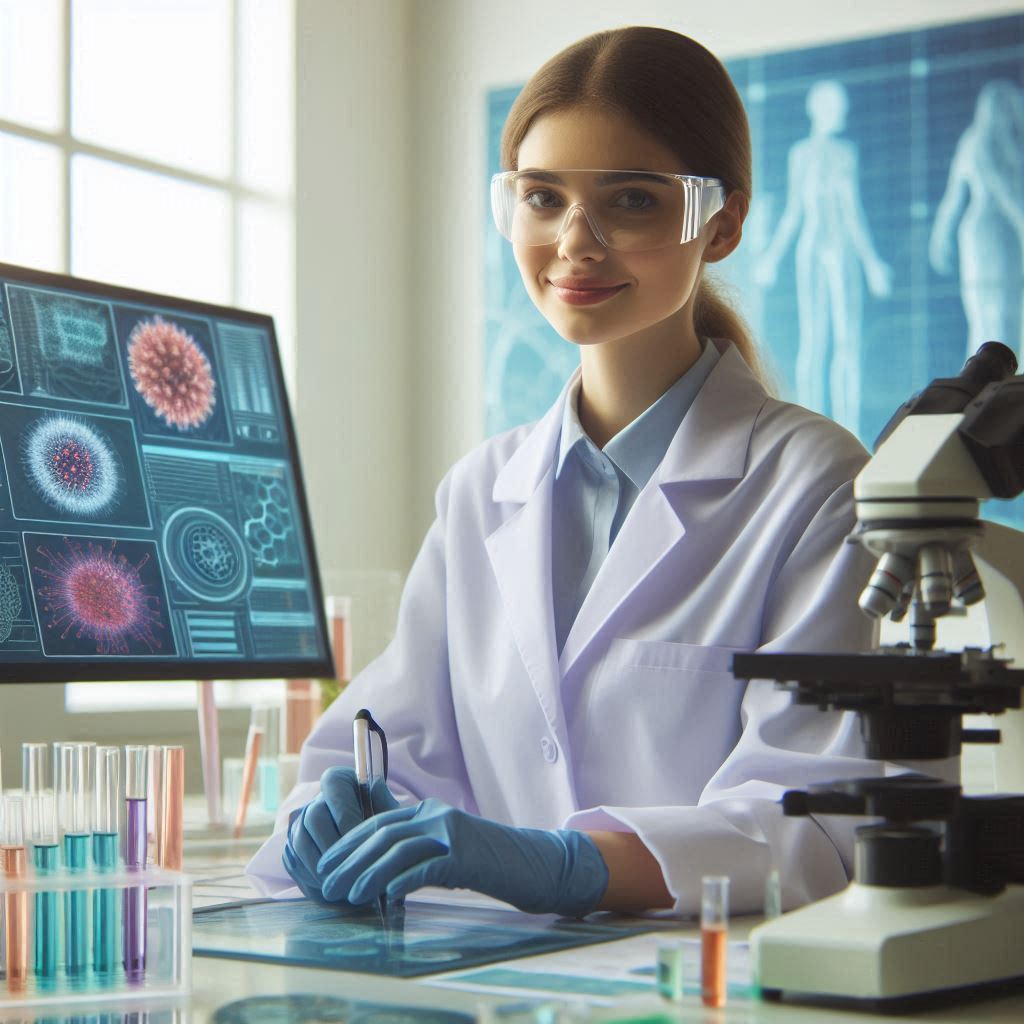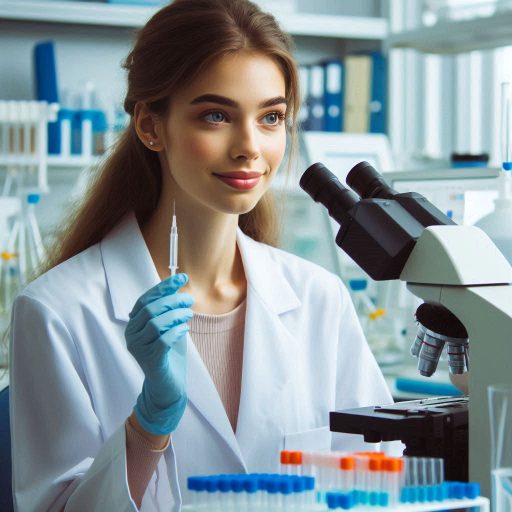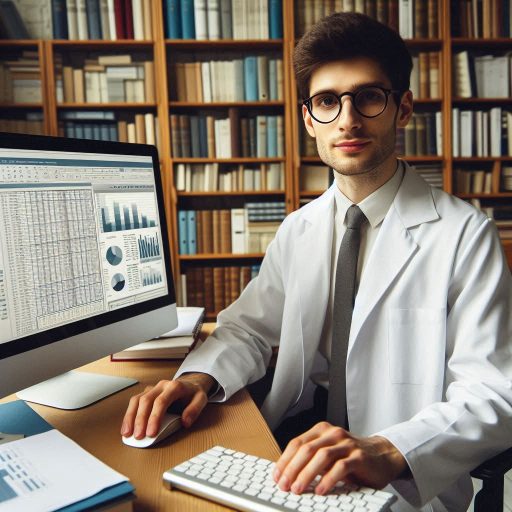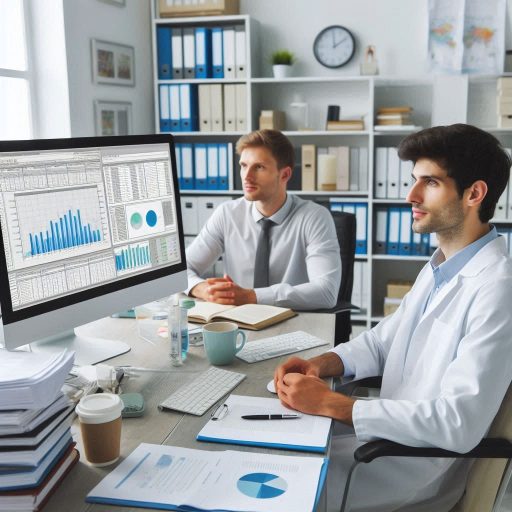Introduction
Lab safety protocols play a critical role in protecting microbiologists and maintaining the integrity of their work.
In microbiology labs, scientists regularly handle hazardous materials such as bacteria, viruses, and other potentially dangerous microorganisms.
Without strict adherence to safety procedures, the risk of exposure to harmful pathogens increases significantly.
This not only endangers the microbiologist but also poses a threat to the wider lab environment.
Cross-contamination of samples is a serious concern in microbiology research, as it can lead to inaccurate results and wasted efforts.
Lab safety practices prevent issues by requiring PPE, following sterilization techniques, and ensuring proper waste disposal.
Following established safety protocols also ensures that the lab complies with regulatory standards, avoiding potential legal or regulatory repercussions.
Safety guidelines minimize the chances of accidents, spills, and contamination, creating a controlled workspace where experiments can be conducted efficiently.
Strict adherence to these protocols enhances the reliability of research findings and safeguards the health of all personnel involved.
Personal Protective Equipment (PPE)
Microbiologists work with harmful microorganisms and chemicals that pose potential health risks.
To mitigate these hazards, wearing personal protective equipment (PPE) is essential.
Proper PPE minimizes the risk of exposure to biohazards and dangerous chemicals.
Necessary PPE for microbiologists (e.g. gloves, lab coat, goggles)
Microbiologists must wear specific protective gear to ensure their safety.
The following are common types of PPE in microbiology labs:
- Gloves: Gloves are essential for protecting hands from contamination.
They prevent skin contact with harmful microorganisms, chemicals, and other biohazards.
Disposable gloves are typically used to minimize cross-contamination between samples.
Always ensure that gloves are properly fitted and disposed of after use. - Lab Coat: A lab coat serves as a barrier between the wearer and harmful substances.
It protects personal clothing from exposure to biological agents, chemicals, and spills.
Lab coats should be long-sleeved and made from flame-resistant material.
Always remove lab coats before leaving the lab to avoid spreading contaminants. - Goggles: Goggles protect the eyes from chemical splashes, airborne pathogens, and other harmful particles.
Microbiologists often handle materials that can cause eye irritation or infection if splashed.
Ensure that the goggles fit snugly and provide a complete seal around the eyes. - Face Mask or Respirator: Face masks or respirators protect the respiratory system from inhaling harmful microorganisms, chemical fumes, and aerosols.
Respirators provide a higher level of protection compared to regular face masks, especially in environments with airborne biohazards. - Closed-Toe Shoes: Closed-toe shoes provide protection from spills, dropped materials, and hazardous chemicals.
Shoes should cover the entire foot, preventing exposure to harmful substances on the lab floor.
Importance of wearing PPE to protect against biohazards and chemicals
Proper use of PPE is crucial for protecting microbiologists from exposure to biohazards and chemicals.
Failure to wear the appropriate protective gear can result in severe health risks, including infections, chemical burns, and respiratory issues.
PPE creates a barrier between the microbiologist and hazardous materials, reducing the risk of accidental contamination.
Key reasons to wear PPE include:
- Protection from Biohazards: Microbiologists frequently handle harmful microorganisms that can cause infections if not properly contained.
- Chemical Safety: Exposure to chemicals can cause burns, irritation, or long-term health complications. PPE prevents direct contact.
- Prevention of Cross-Contamination: Proper use of gloves and lab coats prevents the transfer of contaminants from the lab to other areas.
Wearing the correct PPE is essential for ensuring safety in microbiology labs.
It protects against biohazards, chemicals, and cross-contamination, ensuring a safer work environment for microbiologists.
Read: U.S. Cities with the Most Opportunities for Environmental Scientists
Handling Microorganisms
Guidelines for safe handling of microorganisms
Microbiologists must follow strict protocols when handling microorganisms to prevent contamination and ensure safety.
Improper handling can lead to contamination, exposure, or accidental infections.
Below are the key guidelines and techniques every microbiologist should follow to minimize risks.
Wear Proper Personal Protective Equipment (PPE)
Always wear PPE when working with microorganisms.
Standard PPE includes:
- Lab coats or gowns
- Gloves (change regularly)
- Protective eyewear or face shields
- Masks or respirators (if necessary)
PPE provides a crucial barrier between you and harmful microorganisms, reducing exposure.
Practice Good Aseptic Techniques
Using proper aseptic techniques prevents contamination of both samples and the environment.
Key practices include:
- Sterilize equipment before and after use
- Use flame sterilization for inoculation loops and needles
- Work within a laminar flow hood when possible
- Avoid touching sterile surfaces with bare hands or gloves
Aseptic practices are vital in preventing cross-contamination and maintaining sample integrity.
Minimize Aerosol Generation
Microbiologists must minimize aerosol generation to reduce the risk of inhaling harmful microorganisms.
Follow these steps:
- Avoid vigorously shaking liquid cultures
- Use closed systems for transferring liquids
- Centrifuge samples with lids tightly secured
Aerosols can spread microorganisms quickly, increasing the risk of exposure.
Label Samples and Containers Clearly
Clearly label all samples and containers with relevant details.
Labels should include:
- Name of microorganism
- Date of collection or creation
- Hazard level (if applicable)
Accurate labeling ensures proper handling and prevents accidental exposure to unknown agents.
Dispose of Waste Properly
Proper waste disposal is essential for avoiding contamination.
Dispose of all biohazardous waste in:
- Designated biohazard containers
- Autoclaves for sterilization before disposal
Following waste disposal protocols reduces environmental contamination and keeps the lab safe.
Maintain a Clean Work Environment
Always maintain a clean work area by regularly disinfecting surfaces.
Key practices include:
- Use 70% ethanol or bleach solutions to clean surfaces
- Clean spills immediately
- Avoid clutter around your workspace
A clean environment reduces the risk of accidental contamination.
Transform Your Career Today
Unlock a personalized career strategy that drives real results. Get tailored advice and a roadmap designed just for you.
Start NowImportance of proper technique to prevent contamination and exposure
Proper technique is crucial for preventing contamination, ensuring accurate results, and maintaining personal safety.
Carelessness can lead to infections, incorrect data, and potential laboratory shutdowns.
Consistently practicing these guidelines keeps you and your colleagues safe while maintaining the integrity of your work.
In summary, handling microorganisms safely requires the right PPE, aseptic techniques, clear labeling, waste disposal, and work environment cleanliness.
By following these guidelines, microbiologists can minimize risks and ensure a safe and productive lab environment.
Read: Environmental Scientist vs. Ecologist: Roles and Differences in the US
Decontamination Procedures
Overview of decontamination methods (e.g. autoclaving, chemical disinfection)
Autoclaving
Autoclaving is one of the most effective and widely used methods for decontaminating laboratory equipment and waste.
This process involves subjecting items to high pressure and steam at a temperature of 121‘C for a specified duration, typically ranging from 15 to 60 minutes.
The high temperature and pressure effectively destroy bacteria, viruses, fungi, and spores, making autoclaving a reliable method for achieving sterilization.
It is commonly used for glassware, instruments, and biohazardous waste.
Some materials may degrade or sustain damage from high temperatures and moisture.
Therefore, proper loading techniques and monitoring of autoclave parameters are crucial for ensuring successful decontamination.
Chemical Disinfection
Chemical disinfection is another essential decontamination method, employing various disinfectants to kill or inactivate pathogens on surfaces and equipment.
Common disinfectants used in microbiology labs include:
- Bleach (sodium hypochlorite): Effective against a wide range of microorganisms, bleach is often used for disinfecting surfaces and equipment.
- Ethanol: Typically used in concentrations of 70%, ethanol is effective against many bacteria and viruses.
- Hydrogen Peroxide: This disinfectant can be used for surface decontamination and as a vapor for more comprehensive sterilization.
- Quaternary Ammonium Compounds: Often used for surface cleaning, these compounds are effective against bacteria and some viruses.
To ensure effective decontamination, it is vital to use the appropriate concentration of disinfectant and follow the recommended contact time specified by the manufacturer.
Importance of thorough decontamination to prevent spread of pathogens
Thorough decontamination is essential for maintaining a safe and hygienic laboratory environment.
The following points illustrate the key reasons why rigorous decontamination practices are crucial:
Preventing Cross-Contamination
Inadequate decontamination can lead to cross-contamination, where pathogens are unintentionally transferred from one surface or material to another.
Ensuring that all surfaces, equipment, and materials are properly decontaminated minimizes the risk of cross-contamination and supports the reliability of laboratory findings.
Protecting Researchers and Staff
The health and safety of laboratory personnel are paramount.
Implementing proper decontamination practices helps minimize these risks, ensuring a safer work environment for researchers and staff.
Regular training on decontamination procedures and personal protective equipment (PPE) is essential for enhancing safety awareness.
Maintaining Lab Integrity
Decontamination is crucial for maintaining the integrity of laboratory research activities.
By adhering to thorough decontamination procedures, researchers can uphold the integrity of their work, contributing to the advancement of scientific knowledge.
Compliance with Regulations
Regulatory bodies like the Centers for Disease Control and Prevention (CDC) and the Occupational Safety and Health Administration (OSHA) set specific guidelines.
They require decontamination in laboratory settings to ensure safety and compliance.
Regular audits and inspections can help laboratories stay compliant with these guidelines and maintain high standards of hygiene.
Overall, proper decontamination procedures are essential for maintaining a safe and hygienic working environment in microbiology labs.
Researchers can minimize contamination risk by following appropriate methods and guidelines.
They can protect their health through proper safety measures.
Ensuring the accuracy of research outcomes requires diligent adherence to these practices.
Establishing a culture of safety and diligence around decontamination practices enhances laboratory operations.
It also strengthens the overall integrity of scientific research.
Read: The Relationship Between U.S. Policy & Environmental Scientist Roles
Waste Management
Proper waste management is crucial for microbiologists.
It ensures safety and protects the environment from harmful substances.
This section focuses on biohazardous waste disposal and the importance of waste segregation.
Proper Disposal of Biohazardous Waste Materials
Microbiologists often work with potentially hazardous materials.
Biohazardous waste includes cultures, contaminated equipment, and personal protective equipment (PPE).
To minimize risks, laboratories must follow strict disposal protocols.
Biohazardous waste should be collected in designated containers.
Use puncture-resistant, leak-proof bags or bins for sharps and liquid waste.
Clearly label all containers with biohazard symbols to indicate the presence of hazardous materials.
This labeling ensures that everyone in the lab recognizes the risks.
Regularly scheduled waste disposal prevents the accumulation of biohazardous materials.
Assign a specific time for waste collection to maintain a safe working environment.
Designate trained personnel to handle waste disposal procedures.
They should follow local regulations and institutional policies.
Importance of segregating different types of waste for safety and environmental reasons
Segregation is essential in waste management for safety and environmental reasons.
Different types of waste require specific handling and disposal methods.
Improper segregation can lead to contamination and increased health risks.
Separate biohazardous waste from regular trash.
This helps prevent cross-contamination and protects waste management personnel.
It also ensures that hazardous materials receive appropriate treatment.
In addition to biohazardous waste, microbiology labs produce recyclable and chemical waste.
Clearly define categories for these waste types.
Use separate containers for sharps, liquid waste, and recyclable materials.
This practice simplifies waste management and promotes responsible disposal.
Environmental Impact of Waste Management
Waste segregation not only protects human health but also benefits the environment.
Improper disposal of biohazardous waste can lead to environmental contamination.
This contamination can affect soil, water sources, and local ecosystems.
Proper disposal methods mitigate these risks.
Treatment facilities can safely process biohazardous materials, reducing the chances of environmental harm.
Responsible waste management demonstrates a commitment to public health and environmental protection.
Microbiologists play a vital role in ensuring effective waste management practices.
By adhering to proper disposal protocols, they contribute to a safer lab environment.
Their efforts also help protect the surrounding community from potential hazards.
Effective waste management is critical for microbiologists.
Proper disposal of biohazardous waste and segregation of different waste types are essential for safety.
By following established protocols, microbiologists can ensure a safe working environment and protect the environment.
Adopting these practices demonstrates professionalism and responsibility in laboratory settings.
Read: Organizations & Associations for Environmental Scientists in the USA
Transform Your Career Today
Unlock a personalized career strategy that drives real results. Get tailored advice and a roadmap designed just for you.
Start Now
Emergency Response
Procedures for handling lab accidents or spills
Laboratories are essential environments for scientific research, education, and innovation.
However, the potential for accidents or spills in a lab setting is a critical concern that requires preparedness and knowledge.
Establishing clear procedures is vital to ensure safety and minimize risks.
Immediate Response
- Assess the Situation: When an accident or spill occurs, the first step is to assess the nature and extent of the incident.
Identify the materials involved and evaluate any immediate dangers, such as chemical exposure, fire risks, or physical hazards. - Ensure Personal Safety and the Safety of Others: Before addressing the spill or accident, prioritize personal safety.
Use personal protective equipment (PPE) such as gloves, goggles, and lab coats.
Ensure that others in the vicinity are safe; if necessary, initiate an evacuation of the area.
Containment Measures
- Use Spill Kits and Absorbent Materials: Every lab must have spill kits for different materials.
These kits should include those for chemicals, biological substances, and hazardous waste. - Seal Off the Area to Prevent Further Contamination: If safe to do so, cordon off the affected area to prevent others from entering.
Use barriers or signage to inform others of the potential hazard.
Notification Protocol
- Inform Lab Supervisors or Emergency Contacts: Promptly notify the lab supervisor or designated safety officer about the incident.
Provide clear details regarding the nature of the spill or accident, the materials involved, and any immediate dangers. - Document the Incident for Reporting: Accurate documentation is vital for understanding the incident’s causes and for compliance purposes.
Record details such as the time, location, materials involved, and actions taken.
Importance of knowing how to respond quickly and effectively in case of an emergency
In the fast-paced environment of a laboratory, emergencies can arise unexpectedly.
Having the knowledge and skills to respond quickly and effectively is critical to ensuring safety and minimizing potential damage.
Protecting Lives
- Quick Responses Can Save Lives and Minimize Injuries: In emergencies, time is of the essence.
Knowing how to act swiftly can prevent injuries or fatalities. - Awareness of Emergency Procedures Is Critical: Regular training and drills keep personnel familiar with emergency procedures.
They learn evacuation routes, emergency contacts, and first-aid measures.
Minimizing Damage
- Rapid Action Helps Limit Damage to Facilities and Equipment: Quick responses not only protect individuals but also safeguard lab equipment and facilities.
- Effective Containment Can Prevent Environmental Contamination: Promptly contain spills involving hazardous materials to prevent environmental damage.
Act quickly to minimize the impact on surrounding areas.
Boosting Confidence
- Training Fosters a Culture of Safety: Regular training sessions instill a sense of confidence among lab personnel.
- Prepared Individuals Can Act Decisively in Emergencies: Confidence in emergency procedures enables individuals to take charge when needed.
Laboratories can create a safer working environment by following established procedures for handling lab accidents.
They must understand the importance of quick responses in emergencies.
Training, awareness, and effective communication are essential components that contribute to a culture of safety and preparedness in scientific settings.
Training and Education
Importance of regular safety training for microbiologists
Regular safety training is crucial for microbiologists.
It helps prevent accidents and ensures a safe working environment.
Microbiologists handle various hazardous materials.
Thus, understanding safety protocols is essential for their protection and that of others.
Training programs should cover:
- Personal Protective Equipment (PPE): Proper use of gloves, masks, and lab coats.
- Chemical Safety: Handling, storing, and disposing of chemicals safely.
- Biological Safety: Understanding biosafety levels and associated risks.
- Emergency Procedures: Knowing how to respond to spills, exposures, or other emergencies.
Regular training sessions reinforce knowledge.
They also provide opportunities for hands-on practice.
Microbiologists gain confidence in applying safety protocols in real situations.
Benefits of staying updated on safety protocols and procedures
Staying current with safety protocols is vital for microbiologists.
Safety regulations and best practices evolve frequently.
Regular updates ensure microbiologists work in compliance with the latest standards.
The benefits of staying updated include:
- Enhanced Safety Awareness: Knowledge of the latest safety measures reduces the risk of accidents.
- Improved Compliance: Regular training ensures adherence to institutional and regulatory guidelines.
- Increased Efficiency: Familiarity with protocols streamlines lab procedures and minimizes delays.
- Reduced Liability: Proper training protects against legal issues resulting from safety violations.
- Boosted Confidence: Understanding safety protocols instills confidence in handling potentially hazardous materials.
Regular training also fosters a culture of safety within the laboratory.
When microbiologists prioritize safety, everyone benefits.
They can share knowledge with colleagues and promote safe practices.
This culture helps prevent accidents and protects all lab personnel.
Furthermore, microbiologists should engage in continuous education.
Attending workshops, seminars, and conferences keeps them informed about the latest developments.
These events often highlight advancements in safety technologies and practices.
In addition to formal training, self-education plays a role.
Microbiologists can access online resources and industry publications.
These materials often cover updates on safety protocols and guidelines.
Lastly, institutions should prioritize training.
They must allocate time and resources for regular safety sessions.
Providing access to up-to-date information ensures all staff members remain informed.
Training and education on safety protocols are essential for microbiologists.
Regular safety training enhances awareness and compliance.
Staying updated on procedures increases efficiency and reduces risks.
Institutions must invest in training to foster a culture of safety.
This commitment protects microbiologists and enhances the overall safety of laboratory environments.
Delve into the Subject: Day in the Life of a Marine Biologist
Equipment Maintenance
Maintaining lab equipment is crucial for safety and accuracy in microbiological research.
Well-maintained equipment reduces risks and enhances reliable results.
Proper maintenance procedures can prevent accidents and ensure that experiments yield valid data.
Here are key aspects to consider for effective equipment maintenance in microbiology labs.
The importance of maintaining lab equipment to ensure safety and accuracy of results
- Safety: Faulty equipment can lead to hazardous situations.
Regular maintenance helps identify and fix potential hazards. - Accuracy: Equipment that operates improperly may produce unreliable data.
Accurate results depend on well-calibrated and maintained tools. - Longevity: Proper maintenance extends the lifespan of lab equipment.
Investing time in maintenance saves money on replacements. - Compliance: Many regulations require regular maintenance and calibration of laboratory equipment.
Adhering to guidelines helps ensure compliance with safety standards. - Efficiency: Well-maintained equipment operates more efficiently.
This efficiency allows for faster and more reliable results.
Guidelines for regular maintenance and calibration of equipment
To ensure safety and accuracy, microbiologists should follow these guidelines for equipment maintenance:
Develop a Maintenance Schedule
Create a schedule for regular maintenance of all lab equipment.
Include daily, weekly, monthly, and annual tasks.
Ensure all staff members know and follow the schedule.
Perform Routine Inspections
Regularly inspect equipment for signs of wear and tear.
Look for leaks, unusual noises, or misalignments.
Document findings and address issues promptly.
Clean Equipment Thoroughly
Establish a cleaning protocol for all lab equipment.
Use appropriate cleaning agents and techniques based on equipment type.
Regular cleaning prevents contamination and ensures proper functioning.
Calibrate Instruments
Calibration is essential for ensuring accuracy.
Follow the manufacturer‘s guidelines for calibration frequency.
Use standard reference materials for precise calibration.
Replace Worn Parts
Identify and replace worn or damaged components immediately.
Keeping spare parts on hand can minimize downtime and maintain operational efficiency.
Train Staff on Equipment Use
Provide training for all personnel on the proper use and maintenance of equipment.
Ensure everyone understands the importance of maintenance for safety and accuracy.
Maintain Detailed Records
Keep detailed records of maintenance activities, inspections, and calibrations.
These records can help track equipment performance and identify recurring issues.
Equipment maintenance plays a vital role in laboratory safety and research accuracy.
By following these guidelines, microbiologists can ensure their equipment operates effectively.
Regular maintenance reduces risks, enhances results, and contributes to a safer lab environment.
Prioritize equipment care to maintain high standards in microbiological research.
Transform Your Career Today
Unlock a personalized career strategy that drives real results. Get tailored advice and a roadmap designed just for you.
Start NowSee Related Content: Bioinformatics in Cancer Research: Key Contributions
Communication and Reporting
Effective communication and reporting are essential for maintaining safety in microbiology labs.
These practices help identify hazards, share information, and prevent accidents.
Below, we discuss the importance of communicating potential hazards and guidelines for reporting incidents.
Importance of communicating potential hazards to colleagues and supervisors
Microbiologists must communicate potential hazards to colleagues and supervisors.
Doing so fosters a culture of safety and awareness.
Here are some key reasons why communication is vital:
- Promotes Awareness: Regularly discussing hazards keeps everyone informed about potential risks in the lab.
- Enhances Collaboration: Sharing safety concerns encourages teamwork and collective problem-solving.
- Facilitates Training: Clear communication helps new staff learn about hazards and safe practices more quickly.
- Reduces Risks: Informing others about hazards allows for proactive measures to mitigate risks.
- Improves Response: When everyone knows potential hazards, they can respond effectively in emergencies.
Guidelines for reporting incidents and near misses to prevent future accidents
Reporting incidents and near misses is crucial for preventing future accidents.
Establishing clear guidelines helps ensure that staff report issues promptly and accurately.
Here are steps to follow when reporting incidents:
- Notify Supervisors Immediately: Always inform your supervisor of any incidents, regardless of severity.
- Document the Incident: Write down the details, including the date, time, location, and nature of the incident.
- Identify Contributing Factors: Analyze what led to the incident. Consider equipment failure, procedural lapses, or lack of training.
- Report Near Misses: Report near misses to help identify potential hazards before they result in an incident.
- Follow Established Procedures: Use the lab‘s incident reporting form or system to ensure proper documentation.
- Encourage Open Communication: Create an environment where staff feel comfortable reporting issues without fear of retaliation.
- Review Reports Regularly: Supervisors should regularly review incident reports to identify patterns and areas for improvement.
- Provide Feedback: Share findings from incident investigations with the team. This reinforces the importance of communication and reporting.
In microbiology labs, effective communication and reporting are vital components of safety protocols.
By openly discussing potential hazards and adhering to reporting guidelines, microbiologists can prevent accidents and promote a safer working environment.
Prioritizing these practices creates a culture of safety, ensuring everyone is aware of risks and prepared to respond appropriately.
Implementing these measures enhances overall lab safety and fosters a collaborative atmosphere among colleagues.
Remember, a proactive approach to communication and reporting can save lives and prevent injuries.
Gain More Insights: How to Become a Marine Biologist
Conclusion
Following lab safety protocols is crucial for microbiologists.
These protocols safeguard not only the researchers but also the environment and public health.
Proper training and awareness significantly reduce risks in the laboratory.
Microbiologists should undergo comprehensive training programs to understand potential hazards.
Always wear personal protective equipment (PPE), such as gloves, lab coats, and safety goggles, to minimize exposure to harmful substances.
Using biosafety cabinets is vital for handling pathogenic organisms, as they prevent airborne transmission and protect the user.
Regularly disinfecting workspaces and equipment helps minimize contamination and ensures a clean working environment.
Additionally, practicing proper waste disposal techniques protects both microbiologists and the environment.
Dispose of hazardous materials according to established guidelines to prevent environmental contamination.
Adhering to safety guidelines promotes a culture of safety in the lab.
By following these protocols, microbiologists can prevent accidents and ensure their well-being.
A safe laboratory environment fosters better research outcomes and protects public health.
Moreover, prioritizing safety protocols enhances overall productivity, as researchers can focus on their work without distractions or worries about safety risks.




